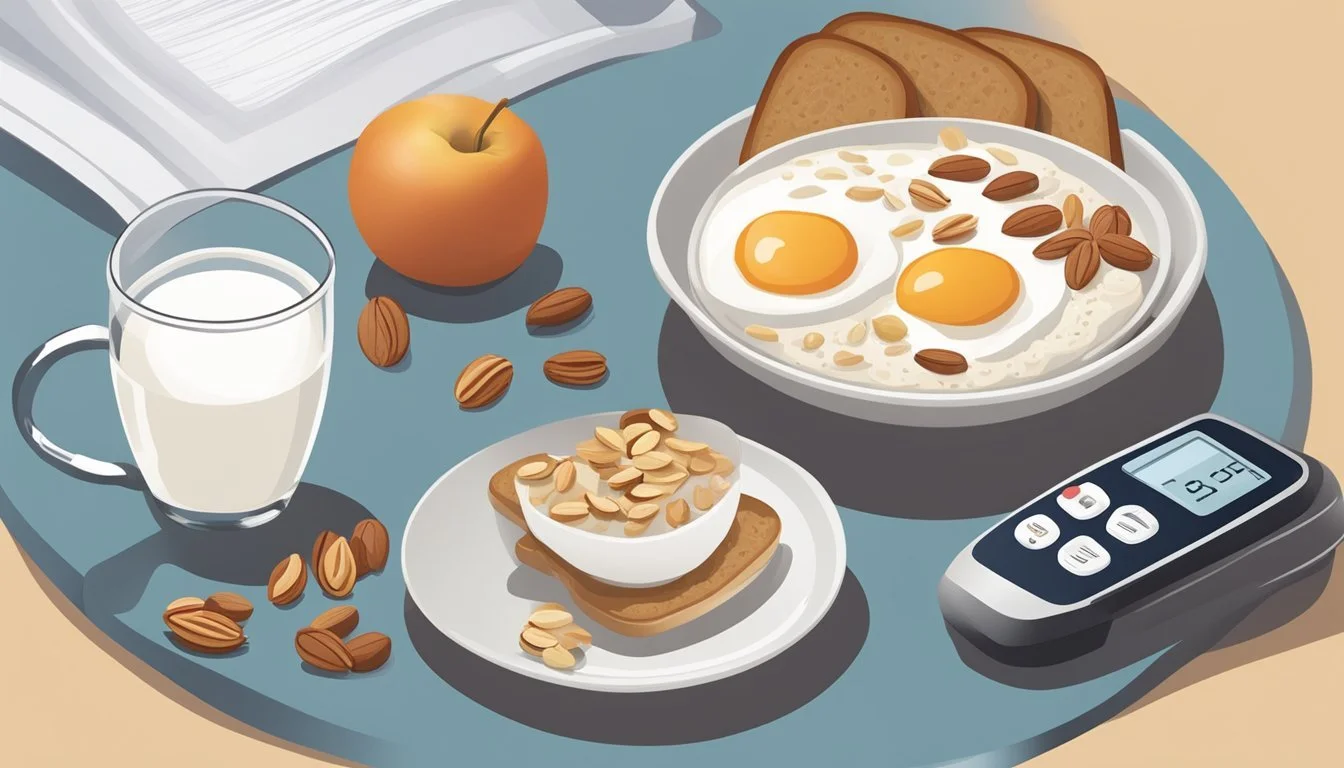Delicious Diabetes-Friendly Breakfast Ideas for Stable Blood Sugar
Starting the day with a nutritious breakfast is crucial for managing diabetes and maintaining stable blood sugar levels. A well-balanced morning meal can provide sustained energy, support weight management, and help control glucose throughout the day. Diabetes-friendly breakfast options focus on complex carbohydrates, lean proteins, and healthy fats to promote better blood sugar control.
Many delicious and satisfying breakfast choices are suitable for people with diabetes. Whole grain toast with avocado and eggs, Greek yogurt parfaits with berries and nuts, or vegetable omelets are just a few examples of tasty options that align with a diabetes-friendly diet. These meals combine fiber, protein, and essential nutrients to keep you feeling full and energized.
Incorporating a variety of foods into your breakfast routine can help prevent boredom and ensure you're getting a wide range of nutrients. By choosing ingredients wisely and paying attention to portion sizes, individuals with diabetes can enjoy flavorful morning meals while effectively managing their blood sugar levels.
Understanding the Basics of Diabetes and Breakfast
Breakfast plays a crucial role in managing diabetes. It helps regulate blood sugar levels and provides essential nutrients to start the day.
The Role of Breakfast in Blood Sugar Management
Eating breakfast helps stabilize blood glucose levels after the overnight fast. It prevents sharp spikes in blood sugar that can occur when skipping meals.
A balanced breakfast also improves insulin sensitivity throughout the day. This makes it easier for the body to process carbohydrates.
Consuming protein and fiber at breakfast slows digestion and glucose absorption. This leads to more gradual rises in blood sugar levels.
Eating breakfast may reduce overall calorie intake later in the day. This can aid in weight management, which is important for diabetes control.
Essential Nutrients for a Diabetes-Friendly Breakfast
Protein is vital for a diabetes-friendly breakfast. It promotes satiety and helps maintain stable blood sugar levels.
Good protein sources include:
Eggs
Greek yogurt
Lean meats
Nuts and seeds
Complex carbohydrates provide sustained energy. Whole grains, oats, and quinoa are excellent choices.
Fiber slows digestion and helps manage blood sugar. Berries, chia seeds, and vegetables are rich in fiber.
Healthy fats improve nutrient absorption and promote fullness. Avocados, olive oil, and fatty fish are beneficial options.
Vitamins and minerals support overall health. Colorful fruits and vegetables offer a variety of essential nutrients.
Balanced Breakfast Ideas for Diabetes Health
A balanced breakfast is crucial for managing diabetes. The right combination of nutrients can help stabilize blood sugar levels and provide sustained energy throughout the morning.
High-Protein Choices
Greek yogurt with berries and nuts offers a protein-packed start to the day. The yogurt provides ample protein, while berries add natural sweetness and fiber. A sprinkle of nuts contributes healthy fats and extra protein.
Eggs make an excellent protein-rich breakfast option. Prepare a vegetable omelet with spinach, tomatoes, and mushrooms for added nutrients and fiber. Pair it with a slice of whole-grain toast for complex carbs.
A smoothie made with protein powder, unsweetened almond milk, and low-glycemic fruits like berries can be a quick and nutritious choice. Add a handful of spinach for extra vitamins and minerals without affecting the taste.
Rich in Healthy Fats
Avocado toast on whole-grain bread provides healthy monounsaturated fats and fiber. Top with a poached egg for added protein and omega-3 fatty acids.
Chia seed pudding made with unsweetened almond milk and topped with sliced almonds offers a good balance of healthy fats and protein. Add cinnamon for flavor and potential blood sugar-regulating benefits.
Salmon on a whole-grain English muffin delivers omega-3 fatty acids and protein. Add cucumber slices and a thin spread of cream cheese for a satisfying meal.
Fiber-Focused Meals
Oatmeal is an excellent source of soluble fiber. Prepare it with water or unsweetened almond milk and top with chopped nuts and cinnamon. Add a small amount of fresh fruit for natural sweetness.
A breakfast bowl with quinoa, mixed berries, and pumpkin seeds provides a mix of complex carbs, fiber, and healthy fats. The protein in quinoa helps balance the meal.
Whole-grain toast with sugar-free peanut butter and sliced apple offers a good balance of fiber, protein, and healthy fats. The apple provides natural sweetness and extra fiber to help regulate blood sugar.
Diabetes-Friendly Breakfast Recipes
Breakfast options for people with diabetes can be both delicious and nutritious. These recipes focus on balancing carbohydrates, protein, and healthy fats to help manage blood sugar levels while providing sustained energy throughout the morning.
Egg-Based Options
Eggs are an excellent protein source for diabetics. A vegetable-packed omelet combines eggs with fiber-rich veggies like spinach, bell peppers, and mushrooms. For a portable option, try egg muffins made with beaten eggs, cheese, and diced vegetables baked in a muffin tin.
Tofu scramble offers a plant-based alternative. Crumble firm tofu and sauté with turmeric, nutritional yeast, and vegetables for a protein-rich meal. Add a side of sliced avocado for healthy fats.
Wholesome Grains and Seeds
Overnight oats provide a convenient, fiber-rich breakfast. Mix rolled oats with unsweetened almond milk, chia seeds, and a small amount of fresh berries. Refrigerate overnight for a creamy, no-cook meal.
Chia pudding is another seed-based option. Combine chia seeds with unsweetened plant milk and let sit overnight. Top with a sprinkle of nuts and cinnamon for added flavor and nutrients.
For a warm option, try a small portion of steel-cut oats topped with sliced almonds and a dollop of Greek yogurt.
No-Cook Breakfasts
Greek yogurt parfaits layer protein-rich yogurt with fresh berries and a sprinkle of low-sugar granola. This quick assembly provides a balance of protein, carbs, and healthy fats.
Smoothies offer endless variety. Blend spinach, unsweetened almond milk, a small banana, and a scoop of protein powder for a nutrient-dense drink. Add a tablespoon of chia seeds for extra fiber.
A simple combo of hard-boiled eggs, sliced vegetables, and a small piece of whole-grain toast creates a balanced plate with minimal preparation.
Savory Breakfasts
Avocado toast on whole-grain bread provides healthy fats and fiber. Top with sliced tomatoes and a sprinkle of everything bagel seasoning for added flavor.
Sweet potato toast offers a creative alternative to bread. Slice sweet potato thinly, toast, and top with mashed avocado and a poached egg for a nutrient-dense meal.
A breakfast burrito bowl combines scrambled eggs or tofu with black beans, diced tomatoes, and a small amount of cheese. Add sliced avocado and a dollop of Greek yogurt for creaminess.
Ingredients and Alternatives to Enhance Your Breakfast
Incorporating nutrient-dense ingredients and smart substitutions can transform your diabetes-friendly breakfast. These options provide essential vitamins, minerals, and fiber while helping maintain stable blood sugar levels.
Superfoods for a Nutrient Boost
Berries are excellent additions to diabetic breakfasts. Blueberries and strawberries are low in calories and packed with antioxidants. They can be added to oatmeal, yogurt, or smoothies for a flavorful nutrient boost.
Cinnamon is another powerful ingredient. It may help improve insulin sensitivity and lower blood sugar levels. Sprinkle it on toast, mix it into oatmeal, or add it to coffee for a warming spice kick.
Ginger can be grated into breakfast dishes or steeped as tea. It has anti-inflammatory properties and may help reduce fasting blood sugar levels.
Greek yogurt provides protein and probiotics. It can be topped with nuts or seeds for added crunch and healthy fats.
Low-Glycemic Fruits and Sweeteners
Apples are a smart fruit choice for diabetics. Their high fiber content helps slow down sugar absorption. Sliced apples pair well with nut butter or can be added to breakfast cereals.
Honey can be used as a natural sweetener in moderation. It has a lower glycemic index than refined sugar. Use small amounts to sweeten tea or drizzle over whole grain toast.
Stevia is a zero-calorie natural sweetener that doesn't affect blood sugar. It can replace sugar in beverages or baked goods.
Avocado provides healthy fats and fiber. Mash it on whole grain toast or add slices to an egg white omelet for a creamy texture.
Nutrition and Lifestyle Tips
Managing diabetes involves more than just choosing the right breakfast foods. Proper meal planning, heart-healthy eating habits, and regular physical activity are crucial components of a comprehensive diabetes management strategy.
Planning Diabetes-Friendly Meals
Meal prep can significantly improve blood sugar control for people with type 2 diabetes. Plan meals that include a balance of complex carbohydrates, lean proteins, and healthy fats. Aim for consistent portion sizes and meal times to help regulate blood glucose levels.
Use the plate method: Fill half your plate with non-starchy vegetables, a quarter with lean protein, and a quarter with complex carbohydrates. This approach ensures a balanced intake of nutrients.
Consider using a food diary or smartphone app to track meals and monitor carbohydrate intake. This can help identify patterns and make adjustments to better manage blood sugar levels.
Heart-Healthy Eating Habits
People with diabetes have a higher risk of heart disease, making heart-healthy eating habits essential. Choose foods low in saturated fat, trans fat, and cholesterol. Opt for lean meats, fish, and plant-based protein sources.
Limit sodium intake to less than 2,300 mg per day, as recommended by the American Diabetes Association. Use herbs and spices to add flavor instead of salt.
Include heart-healthy fats like those found in avocados, nuts, and olive oil. These can help improve cholesterol levels and reduce the risk of cardiovascular complications.
Increase fiber intake by consuming whole grains, legumes, fruits, and vegetables. Fiber aids in blood sugar control and promotes heart health.
Physical Activity and Weight Management
Regular exercise is crucial for managing diabetes and maintaining a healthy weight. Aim for at least 150 minutes of moderate-intensity aerobic activity per week, as recommended by health professionals.
Incorporate strength training exercises at least twice a week to build muscle mass and improve insulin sensitivity.
Maintain a consistent exercise routine to help regulate blood sugar levels and reduce the risk of diabetes-related complications.
For those looking to lose weight, create a calorie deficit through a combination of diet and exercise. Even a modest weight loss of 5-10% can significantly improve blood sugar control.
Stay hydrated by drinking water throughout the day, especially during physical activity. Proper hydration supports overall health and helps maintain stable blood sugar levels.
Expert Advice and Responsible Eating
Proper guidance and informed choices are crucial for managing diabetes through diet. Consulting healthcare professionals and understanding nutrition labels empowers individuals to make optimal food decisions.
Consulting with Health Professionals
Registered dietitians and endocrinologists play a vital role in creating personalized meal plans. They consider factors like medication, activity level, and individual health goals. These experts can recommend appropriate portion sizes and glycemic load targets for breakfast foods.
Dietitians may suggest nutrient-dense options that support blood sugar control. They can advise on incorporating vegetarian protein sources if desired. Regular check-ins allow for adjustments based on blood glucose readings and lifestyle changes.
Understanding Food Labels
Reading nutrition facts is essential for making informed breakfast choices. Pay attention to total carbohydrates, fiber, and added sugars. Look for whole grain options with higher fiber content to help slow glucose absorption.
Check serving sizes to accurately gauge carbohydrate intake. Be aware of hidden sugars in seemingly healthy items like flavored yogurts or granola. Compare similar products to find lower-sodium alternatives when possible.
Look for terms like "no added sugars" or "low glycemic index" on packaging. These can indicate more diabetes-friendly options. Remember that "sugar-free" doesn't always mean carbohydrate-free or calorie-free.



